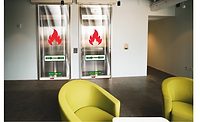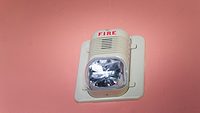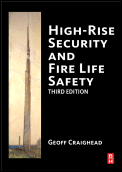
|
Your job title is Security Director, Director of Corporate Security or Chief Security Officer, yet most likely your role entails more than security. As the economy continues its downward trend, corporations have eliminated new positions, leaving open positions unfilled and combining positions. The person responsible for security is now responsible for much more including fire, life safety and safety. But a security director may not be as familiar with fire safety as they are with security matters.
What exactly is fire and life safety? It’s actually many things that range from fire and explosions, to property and people protection. When we are dealing with buildings, that means ensuring people can get out of a building safely in the event of a fire and limiting the amount of damage that will occur. It involves many hazards such as structure fires, fires in cooking and venting equipment, flammable/combustible gases such as natural gas and propane, flammable/combustible liquids, process hazards, electrical hazards and many, many more. A security director needs to be concerned and informed about many of these issues that will vary from facility to facility. The fire protection needs for a medical facility will be vastly different than the fire protection needs for a college campus. If I were to summarize the basics of fire protection, it would be fire prevention, suppression, detection and egress.
Fire Prevention
As a security director, you must become familiar with a State Building Code, NFPA 101, Life Safety Code™, State Fire Prevention Code, and any local codes and regulations (see “A Guide to the Codes” elsewhere in this article). It is these codes that will dictate the requirements that must be complied with, which are often the law. To not comply would be unlawful and could be costly for the owners. Fire prevention is an area that security directors should focus on and is the first step fire safety. Most of the federal, state and local laws and regulations are based upon prevention and mitigation. If you can prevent an event from occurring, you will not incur a loss. Or if you do have a fire, keep the losses to a minimum.
The building codes and NFPA 101, Life Safety Code™ address the building features such as construction type, fire resistive ratings for the floor, ceiling, walls and floors. It will also contain requirements for sprinkler protection and detection systems for the various occupancies. Also, the requirements are different for new construction and renovations versus existing. You should become familiar with the fire protection features of the building including. Does it have a smoke detection system? If so, is it connected to the fire department, the security office, a central station or just a local alarm? Is there a suppression system? If so, what kind?
In some occupancies such as health care facilities, the NFPA 101, Life Safety Code™ requirements must be followed as dictated by the Joint Commission or the Center for Medicare and Medicaid Services (CMS). The Joint Commission requires compliance with the Life Safety Code for accreditation and CMS requires compliance with the Life Safety Code if federal reimbursement is being sought. Where evacuation may be a plausible option for an office building, mall, school and other occupancies where the occupants are capable of self preservation, which is not the case for all occupants in hospitals, nursing homes and other health care facilities. In health care, fire safety involves defense in place. The occupants are not capable of evacuating themselves; therefore fire safety features must be built into the building to protect the occupants. This includes areas of refuge, sprinklers, detection, smoke barriers, automatic door closers, smoke control, fire department notification, the correct number of exits, corridor width and other features.
In some respects, high-rise occupancies have similar requirements for fire protection as health care facilities. In a high rise, there could potentially be thousands of occupants in the building. If an incident was to occur and the building needs to be evacuated, there will be a problem with congestion in the stairwells if all the occupants try to evacuate simultaneously. Evacuation may need to be staged on the floor where the alarm originated, in addition to the floor above and below. The remainder of the occupants would remain on their floors or would relocate to an area of refuge for further instructions.
Fire Suppression
Fire suppression is a key component to fire and life safety. The need for fire suppression and the type of fire suppression will be dictated by the building code and NFPA 101, Life Safety Code™. These codes will specify when suppression is required and often, the type of suppression needed. In most cases, if suppression is required, a sprinkler system is the predominant system. NFPA 13, Standard for the Installation of Sprinkler Systems, is the installation standard that provides the requirements for the proper installation of a sprinkler system. In other cases, special hazards require special systems. For example, the cooking equipment in a commercial kitchen will require a kitchen hood fire protection system. There are dry chemical systems and wet chemical systems to be for the various types of cooking equipment. NFPA 17, Standard for Dry Chemical Extinguishing Systems and NFPA 17A, Standard for Wet Chemical Extinguishing Systems are the installation standards for dry and wet chemical extinguishing systems.
Detection
Detection systems are also a key component in fire protection. In some cases the codes allow tradeoffs between suppression systems and detection and compartmentation. NFPA 101, Life Safety Code™ has requirements for many occupancies. The occupancy chapters will also outline the requirements for each type of occupancy for both new and existing occupancies. Check with your state to determine if the NFPA 101, Life Safety Code™ is required in your state. In addition to the requirements for detection systems in NFPA 101, the installation should be in accordance with NFPA 72, National Fire Alarm and Signaling Code. NFPA 72 contains the requirements for the installation of smoke detectors, heat detectors, flame detectors, gas detectors, signal transmission including proprietary supervising station, central station monitoring, notification appliances and many other functions for the fire alarm system.
Emergency Plan
Every security director should be familiar with the emergency plan and be involved with emergency management. Often fire and security may be at odds with each other, and you need to balance these competing objectives. As part of the emergency plan, consideration must be given to communicating with the first responders to fire and medical issues. How is the communication to be made? Who is the point of contact for the facility? Where will the fire department stage to address the incident? How is crowd control and traffic to be handled? These issues are not code issues and will be different for each situation. Consult with the fire department to address how to work together and handle different situations. Another good reference for emergency management is NFPA 1600, Standard on Disaster/Emergency Management and Business Continuity Programs.
It’s Your Role
Fire and life safety is a specialized field with all types of specialty areas that include life safety, industrial applications, health care, educational, suppression, detection, explosions, special hazards, first responders and fire service and more. Fortunately, the NFPA has more than 300 codes and standards that address almost anything that burns, explodes or how to mitigate the hazards. In today’s world where you are being asked to be the jack of all trades, you can take comfort in knowing there are resources out there to help you. So expand your knowledge base on fire and life safety, as it pays dividends in the end.








